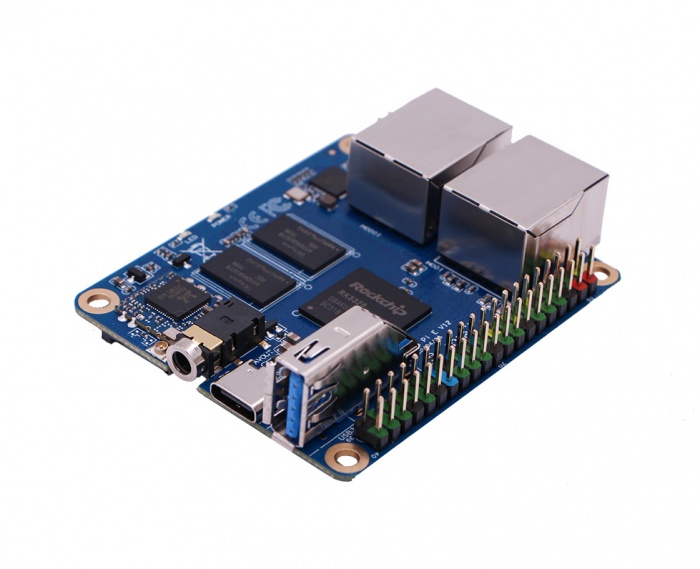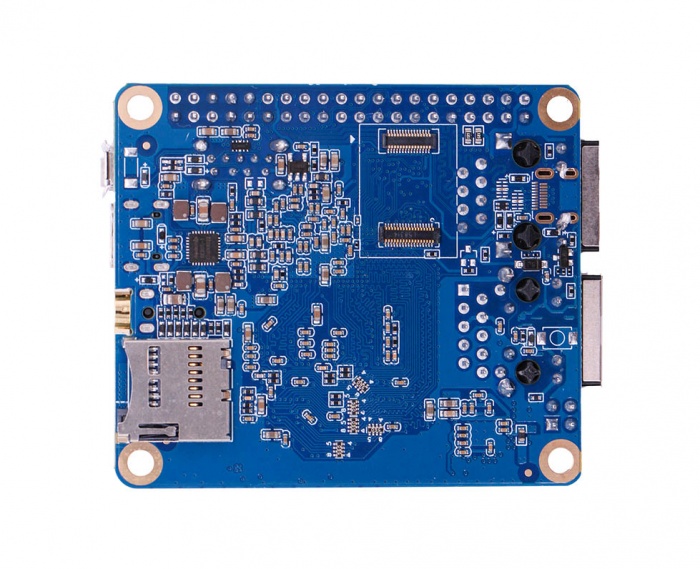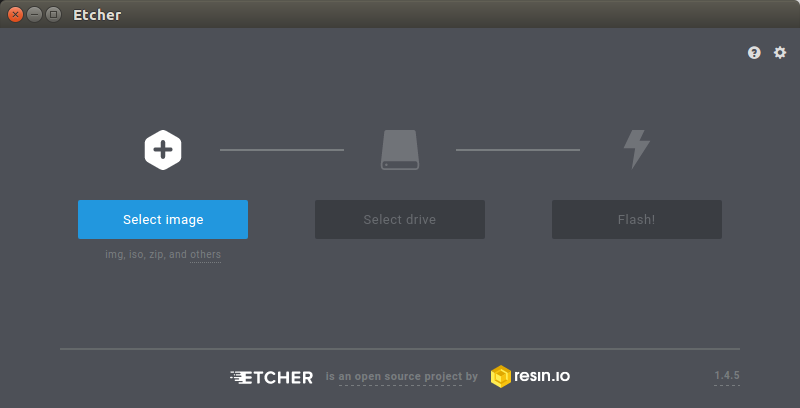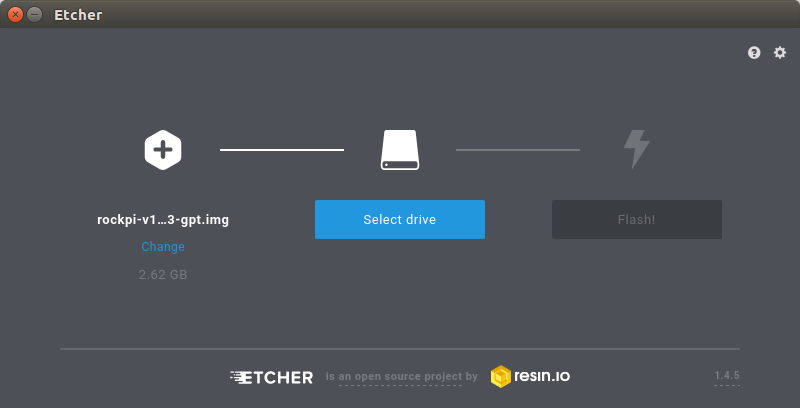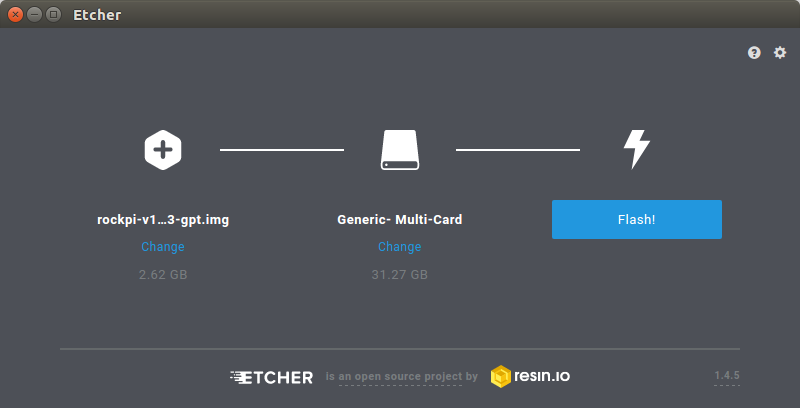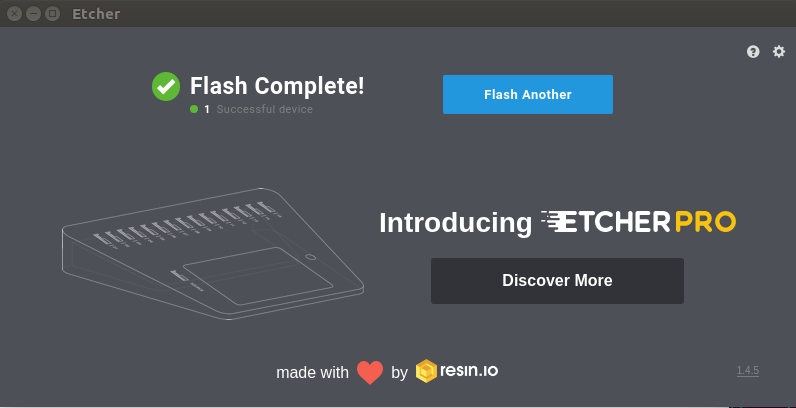Difference between revisions of "RockpiE/getting started"
(→3. Boot the board) |
RadxaYuntian (Talk | contribs) |
||
| (6 intermediate revisions by 2 users not shown) | |||
| Line 39: | Line 39: | ||
== Close look of ROCK Pi E == | == Close look of ROCK Pi E == | ||
* ROCK Pi E front view | * ROCK Pi E front view | ||
| − | [[File: | + | [[File:rockpie_view_front.jpg|700px]] |
* ROCK Pi E front with an angle view | * ROCK Pi E front with an angle view | ||
| − | [[File: | + | [[File:rockpie_view_angle.jpg|700px]] |
* ROCK Pi E back view | * ROCK Pi E back view | ||
| − | [[File: | + | [[File:rockpie_view_back.jpg|700px]] |
== <span id="get_start_specs"></span> Features == | == <span id="get_start_specs"></span> Features == | ||
| Line 61: | Line 61: | ||
|- | |- | ||
! Wireless | ! Wireless | ||
| − | | colspan="2" | 802.11 b/g/n wifi <br /> | + | | colspan="2" | 802.11 b/g/n wifi <br /> BT 4.0(rtl8723du/rtl8821cu) <br /> external antenna |
|- | |- | ||
! USB | ! USB | ||
| Line 130: | Line 130: | ||
=== 3. Boot the board === | === 3. Boot the board === | ||
| − | * Now insert the system | + | * Now insert the system storage media, uSD Card or eMMC Module into the socket on the board. |
* (Optional) Use the USB to TTL serial cable to setup a connection between PC and ROCK Pi E board. See [[rockpiE/dev/serial-console | Serial Console]]. | * (Optional) Use the USB to TTL serial cable to setup a connection between PC and ROCK Pi E board. See [[rockpiE/dev/serial-console | Serial Console]]. | ||
| Line 159: | Line 159: | ||
ssh rock@ip-of-device | ssh rock@ip-of-device | ||
| − | Note: You can also get the IP of ROCK Pi | + | Note: You can also get the IP of ROCK Pi E from option 1 if you can not access network administrator page. |
| + | |||
| + | === 5.Network state === | ||
| + | |||
| + | *Look at network configure: | ||
| + | |||
| + | $ sudo ifconfig | ||
| + | |||
| + | *Test network: | ||
| + | |||
| + | $ ping -c 5 www.google.com | ||
| + | |||
| + | === 6.WIFI Connection === | ||
| + | |||
| + | Check [[rockpiE/Debian#WIFI Connection| WIFI Connection]]. | ||
| + | |||
| + | === 7.BT === | ||
| + | |||
| + | Check [[rockpiE/Debian#BT| BT]]. | ||
| + | |||
| + | === 8.LED === | ||
| + | |||
| + | ROCK Pi E has Power LED and User LED. | ||
| + | |||
| + | * Power LED | ||
| + | |||
| + | The power LED is green. It is always on when ROCK Pi E is given power by default, | ||
| + | |||
| + | * User LED | ||
| + | |||
| + | The user LED is green. By default, its blink status shows the running kernel. | ||
| + | |||
| + | === 9.GPIO === | ||
| + | |||
| + | ROCK Pi E has one 40-pin expansion headers. Each pin is distinguished by color, more information click [https://wiki.radxa.com/RockpiE/hardware/gpio here] | ||
| + | |||
| + | Development for GPIO. ROCK Pi E supports libmraa GPIO library, click [[RockpiE/dev/libmraa | here]] to get more information. | ||
== Next Step == | == Next Step == | ||
Latest revision as of 03:29, 29 September 2022
ROCK Pi E > Getting started
Contents
[hide]This guide is designed for ROCK Pi E enthusiast. The purpose is to learn about the ROCK Pi E board as well as how to prepare and set up for basic use. When you get a board, you need to know what Pi model it is and which hardware version it is. The information is printed in the top side of the board. We will introduce the board information as much as possible.
What you need
Necessary
- ROCK Pi E main board
- One of the Storage media below:
- μSD card, larger than 8GB.
- eMMC Module, larger than 8GB with eMMC to μSD converter board.
- Power supply
- The ROCK Pi E is powered by adapter with type C port and 5V only. If you power adapter supports USB PD, it's safe to power ROCK Pi E.
- USB to TTL serial cable
- ROCK Pi E exports a dedicated serial console, which can access the low level debug message.
Optional
- ROCKPi eMMC USB Reader
- For flashing the system image to eMMC Module.
- μSD Card Reader with eMMC to uSD board
- For flashing the system image to μSD Card or eMMC Module.
- Ethernet cable
- ROCK Pi E supports Internet access via WiFi or Ethernet.
- One or two Ethernet cable are used to connect your ROCK Pi E to a local network and the Internet.
- Audio cable
- Audio can be played through speaker or headphones using a standard 3.5mm jack.
Close look of ROCK Pi E
- ROCK Pi E front view
- ROCK Pi E front with an angle view
- ROCK Pi E back view
Features
| Model | ROCK Pi E | |
|---|---|---|
| Processor | SoC RK3328 Quad Cortex-A53 ARM 64bits processor frequency up to 1.3GHz | |
| Memory | 256MB / 512MB / 1GB / 2GB DDR3 | |
| Storage | MicroSD(TF) up to 128GB High performance eMMC module 16GB / 32GB / 64GB / 128GB | |
| Wireless | 802.11 b/g/n wifi BT 4.0(rtl8723du/rtl8821cu) external antenna | |
| USB | USB3.0 Type-A HOST x1 | |
| Key | Reset key x1 Maskrom key x1 | |
| Ethernet | 1x 1000Mbit ethernet, optional PoE(additional HAT required) 1x 100Mbit ethernet | |
| IO | 40-pin expansion header USB 2.0 x1 I2C x1 SPI x1 UART x2 I2S x1 5V DC power in x2 3.3V DC power in x2 | |
| Others | LEDs | |
| Power | USB Type-C DC 5V | |
| Size | 2.5x2.2 inch(56x65mm) | |
Starting the board for the first time
ROCK Pi E can be started with eMMC Module or μSD Card. Now, you are presented with three options when installing your new operating system onto your ROCK Pi E.
Prepare
- When starting system with eMMC Module
(Option a) Inster the eMMC Module into ROCK Pi eMMC USB Reader. Then plug the ROCK Pi eMMC USB Reader into host PC.
(Option b) Insert eMMC Module into eMMC to μSD card converter board. Insert the converter board into μSD Card Reader. Then plug the Card Reader into host PC.
- When starting system with μSD Card
(Option c) Insert the μSD Card into μSD Card Reader. Then plug the Card Reader into host PC.
Write Image
- Download the official Ubuntu/Debian system image from Downloads.
- Download the flash tool, etcher, from Downloads. Choose the right version for your host operation system. Here we operate on host Ubuntu 16.04.
- After unpacking the package, we run the tool by executing the command
$ ./etcher-etcher-electron-1.4.5-x86_64.AppImage
If you get an error message: "No polkit authentication agent found" you can try and start it with sudo, but do know that this is running the tool as root.
- In the etcher window, click Select image.
- In the etcher window, click Select Drive.
- In the etcher window, click Flash.
- In the etcher window, once it shows us Flash Complete! It is done and can be put into the RockPi.
3. Boot the board
- Now insert the system storage media, uSD Card or eMMC Module into the socket on the board.
- (Optional) Use the USB to TTL serial cable to setup a connection between PC and ROCK Pi E board. See Serial Console.
- Power on ROCK Pi E by adapter with type C port. The input voltage should be 5V.
- ROCK Pi E will boot with the green power Led on. And after a while, the another green Led starts blinking.
4. Access from the Host PC/Laptop
Option 1: Serial console
Check Serial Console
Option 2: SSH
SSH server is enabled on port 22 of ROCK Pi E default image.
Please use angryip to find your board IP address.
To access ROCK Pi E by SSH, try
ping rockpie.local ssh rock@rockpie.local
or if your router/network doesn't support Local Domain, you need to check your network/router administrator page and look for the ROCK Pi E ip address.
ping ip-of-device ssh rock@ip-of-device
Note: You can also get the IP of ROCK Pi E from option 1 if you can not access network administrator page.
5.Network state
- Look at network configure:
$ sudo ifconfig
- Test network:
$ ping -c 5 www.google.com
6.WIFI Connection
Check WIFI Connection.
7.BT
Check BT.
8.LED
ROCK Pi E has Power LED and User LED.
- Power LED
The power LED is green. It is always on when ROCK Pi E is given power by default,
- User LED
The user LED is green. By default, its blink status shows the running kernel.
9.GPIO
ROCK Pi E has one 40-pin expansion headers. Each pin is distinguished by color, more information click here
Development for GPIO. ROCK Pi E supports libmraa GPIO library, click here to get more information.
Next Step
- More Debian image usage and tips
- More Ubuntu image usage and tips
- Checkout the hardware details
- Join the community and the discussion group
Troubleshooting
- Refer Troubleshooting page
- Post your issue on the forum: https://forum.radxa.com/c/rockpie


